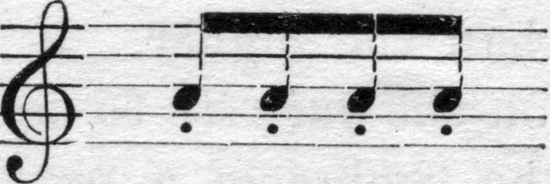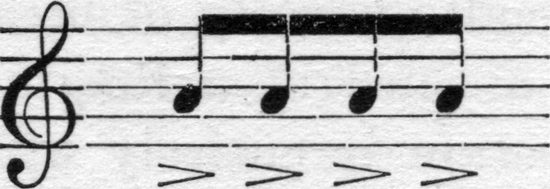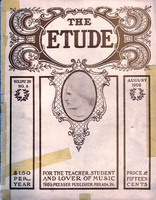A correspondent asks me to explain the apparent inconsistencies in the employment of the staccato sign, and lays some stress on the fact that many admirable violinists either disregard the sign altogether or give it a musical meaning differing from the apparent intention of the composer. Also, he writes that most players with whom he has conversed on the subject have either very hazy notions or no understanding of it whatever.
I must frankly confess that I cannot account for the absurd contradictions that continue to escape our otherwise lynx-eyed publishers. The origin of the whole difficulty may easily be traced to the composer, through whose indifference, or lack of conscientiousness misapplication of the staccato sign has been perpetuated. But it is not easy to understand why, after all that has been said and written on this vexed question, our publishers still continue to remain uninterested in details of their work that certainly deserve their closest attention.
When it is taken into consideration that the staccato dot, as employed to-day, is often the cause of perplexity among experienced players, the despair of the inexperienced in determining its value is little cause for wonderment. Experience and musical instinct often enable the player correctly to decide what the composer had in mind; but the novice is at a decided disadvantage in such matters, and he cannot reasonably be expected to form a correct and independent decision.
Clearly the solution of the problem does not require the efforts of a gigantic intellect. It requires only the concerted action of our publishers, who, with the aid of a capable violinist, can easily decide upon a system of signs and nomenclature whose meaning is unmistakable. Until this sensible step is taken, confusion and misunderstanding will always be inevitable.
My correspondent also calls my attention to the meaning which I give the word detaché, and informs me that a certain writer on violin questions expresses views radically differing from my own. On this point I only care to say that the writer referred to has never been taken seriously in the violin world, nor has it ever occurred to me that his opinions might be regarded as authoritative.
The staccato sign (the dot), when placed either above or below a note, means that that note should be sharply separated from the note that follows it. This sharp separation (or detaché) is accomplished by means of a rapid stroke of the wrist. It may be played, according to circumstances, at the point, the middle, or the heel of the bow; but, if the resultant tone is staccato in character, the stroke which produces it is properly termed detaché. The following illustration may help to make my meaning clearer:
 The perplexed pupil naturally asks: What, then, is the difference—if, indeed, any exists—between the detaché stroke and the martelé? There is, in fact, a marked difference, which every player should readily appreciate. The proper sign for the martelé is as follows:
The perplexed pupil naturally asks: What, then, is the difference—if, indeed, any exists—between the detaché stroke and the martelé? There is, in fact, a marked difference, which every player should readily appreciate. The proper sign for the martelé is as follows:
 The accents clearly indicate that the detached notes should be played with additional force and strength. And, more than this, the sign of the martelé means that the stroke be taken invariably at the point, whereas the detaché may be played with other portions of the bow.
The accents clearly indicate that the detached notes should be played with additional force and strength. And, more than this, the sign of the martelé means that the stroke be taken invariably at the point, whereas the detaché may be played with other portions of the bow.
These are the distinguishing features between the two strokes: detaché and martelé. Regarding the employment of the staccato sign where such bowings as saltato, spiccato, etc., are desired, I shall have something more to say in a future issue of The Etude.



